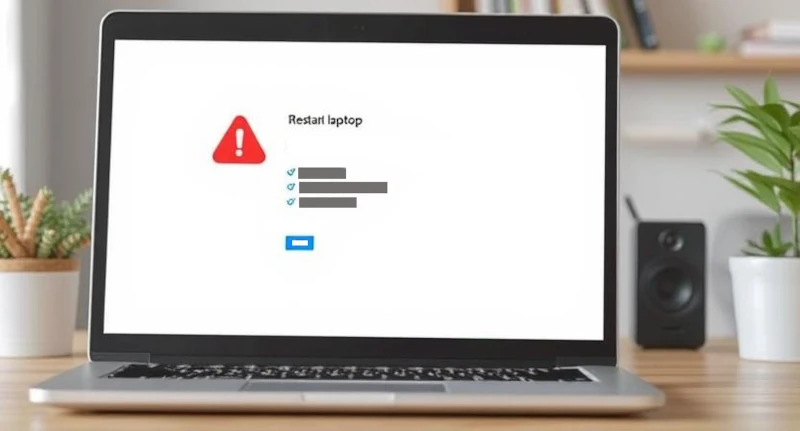How to Restart HP Laptop | Step-by-Step Guide
Learn how to restart an HP laptop with this step-by-step guide, covering standard, force restart, and troubleshooting methods for smooth performance.

Have you ever been in a situation where you do your most important task, and suddenly, everything freezes, causing constant slowdowns?
It could be acting sluggishly, or an update could be causing this. Whatever that case is, restarting your HP laptop is the quickest way to get things straight and make your system run smoothly.
Let's dive into this article and find out how you can restart your laptop safely where no issues arise.
Plus we will explore how to troubleshoot and give you some valuable tips so you can have peace of mind.
So, if you are ready, let's go ahead, shall we?
Why Is Restarting Your HP Laptop So Important?
Before we jump into the how, let's first talk about why. When you restart your laptop, it does more than just turn it off and on again.
Here is how it helps in multiple ways:
- Clears Temporary Junk Files: It flushes out all the unnecessary clogs in your random access memory (RAM for short).
- Fixes Minor Software Glitches: With a simple reboot, many errors that can potentially cause harm will be resolved.
- Perfectly Completes Updates: Some major game-changing updates require restarting them to take full effect.
- Improves Overall Performance: By running for days without a restart, your laptop will eventually become slower.
By doing this, you can regain your system's former power.
Now that we have established the core reasons for this Let's look at the different methods you can use:
The Standard Restart (The Easy Way)
1. Click Start > Power > Restart.
2. Press Ctrl + Alt + Delete > Restart.
3. Press the power button for 10 seconds to force restart.
4. Use Windows + X > Shut down or sign out >Restart.
5. From Command Prompt, type "shutdown /r" andhit Enter.

The most common way is when your operating system is good and responsive.
Steps:
- First, click the Windows icon on the bottom left corner of your screen.
- Then, select the power icon.
- Finally, click Restart.
Voila, your laptop will gradually shut down and then reboot. This is the recommended way to restart your HP laptop without running into any problems.
Restarting with your Keyboard (Shortuct Lover’s Trick)
For some reason, if your touch isn’t working or you are a fan of the keyboard, then you can use shortcut keys to make things quick and easy.
Here’s how you can do it:
- Press Ctrl + Alt +Delete keys on your keyboard
- Then click the power icon at the bottom right.
- Select Restart.
More Simply, you can also use the Alt + F4 keys and then select the Restart option from the drop-down menu of the desktop and select Restart.
Force Restart (When your Laptop Freezes Without Responding)
Sometimes, your laptop freezes, and nothing responds, no matter how hard you try.
In such a scenario, a force restart is the only way.
Steps:
- First of all, press and keep holding the power button for at least 10 to 15 seconds until your laptop shuts down.
- Then wait for 10 to 20 seconds and then press the button to turn it back on.
Caution: Only use this method when all else has failed because it shuts every process down and might cause data loss.
Restarting Using Command Prompt ( For Tech Savy Individuals)
Now, if you are someone who loves technology and wants to know the deepest part of your machine,
Then this step will surely intrigue you. Simply do the following steps:
Press the Windows + R keys.
A new small window will appear. Here, type cmd. Then Press Enter
In the command prompt, type the following: "shutdown /r /t 0". Make sure it's exactly like that.
Then, finally, press enter, and your laptop will instantly shut down and restart.
Please note that this step always comes in handy if you have a really slow system and you want to do things quickly and effectively.
Troubleshooting Restart Issues
Sometimes, things don't really go as planned, and you might get stuck at a loading screen.
There is no need to panic. Be calm and follow these steps, and everything will go smoothly.
So here is how you can deal with all these common problems:

Issue #1: Laptop Stuck on Restart Loading Screen
- Give it some Time: Some updates may take a bit longer to complete, so be patient and let it do its magic.
- Force Reboot: Just press and hold the power button for a while, and it will restart.
- Starting in Safe Mode: You can restart your laptop and then go into the boot menu by pressing different keys.
Sometimes it's F8 or F9 and then you see a menu where there is an option to start in safe mode.
Issue #2: Laptop Won’t Turn back On after a Restart
At other times, when you shut down and try to restart, it just won't turn on. If that happens, make sure to:
- Check The Power Source: Make sure that your charger is correctly connected to the laptop and turned on.
- Removing any External Hardware: Sometimes a rogue USB device will interfere with the Restart like a cooling pad, mouse or a keyboard.
So unplug those devices.
- Doing A Hard Reset: If this is the case then unplug everything. Remove the battery if you can and press the power button for 30 seconds.
After that, put everything back the way it was and see if it helps.
Issue #3: Laptop Automatically Reboots on its Own
In rare cases, your laptop might decide to turn itself on. If that's the case, then the issue might be because of:
- Being Overheated: Clean the air vents where the fan is and make sure everything is clean and tidy with no dust.
- Corrupt Software Drivers: Update and reinstall drivers from the official site or through the Windows Update Center in the settings.
- Faulty Hardware: If the hardware is bad, then this is a problem. The only way to solve this is to take it to the repair shop and have it checked for any damaged parts that might need to be replaced.
It can be expensive or not, depending on your region, but it's all worth it in the end.
Some Handy Pro Tips
Now that we are done with all the details. Make sure to follow these final bits of advice to have a long-lasting journey with your laptop.
After all, you bought it, and it's only reasonable that it should be used responsibly.
- Doing a Restart Once a Week: This keeps your laptop in top condition.
- Being Updated: When everything is green, then all is well.
- Closing any Unneeded Programs: Irrelevant software can sometimes interfere and make things slow so keep an eye out for them.
- Keeping your OS Secured: Make sure your default Windows Defender is on and ready, as it can protect you against any harmful viruses.
- If you are feeling more vulnerable, you can install different antivirus software like Avira, Avast, etc.
- Backing Up Everything: A protected way to prevent data loss in a disaster is to back up your data in physical storage, such as portable hardware, USB flash drives, or cloud storage.
Final Thoughts
In the end, restarting your HP laptop may appear to be a simple procedure, but as we have seen, it is a successful remedy for performance issues, software errors, and even persistent freezes.
Whether it's a click of a button, a keyboard shortcut, or a force restart in a crisis.
Knowing what to do in the heat of the moment puts you in control. And If things go south then solutions like going in Safe Mode or doing a hard reset will save you a lot of headaches.
So restart frequently, keep your system up to date, and enjoy a worry-free experience.






